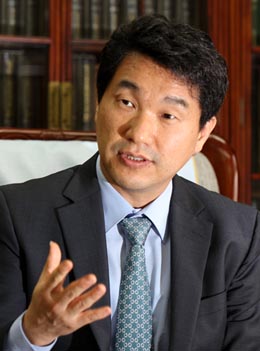‘Quality, not tuition, is main issue’

Lee Ju-ho
Lee was firm in his opinion, saying that the answer is a tough, across-the-board evaluation of universities. “By evaluating all 350 or so universities throughout the country, about 50 colleges in the lowest 15 percent will not be entitled to government support, nor receive any funding.”
In an interview with the JoongAng Ilbo yesterday, Lee said that “in order to increase the quality of university education and to make sure that restructuring is not delayed, state funds should not be injected to all universities.”
Lee noted that “by 2018, the number of people with a college degree will surpass the number of people with a high school degree and by 2024, the number of people with a high school degree will drop by 40 percent.”
The University Structural Reform Committee, which had its first meeting on Tuesday, is considered the starting point of the full-fledged move to restructure universities, said Lee, who added that he will “resolutely accept the proposal made by the committee.”
Q. What is the main problem of universities in Korea?
A. The essence of the crisis is that university education in Korea has expanded in quantity while improvement in quality has been relatively slow. A bill about universities’ structural reform was being discussed for over a decade but legislation has been slow along with the lack of attention from the public.
How can the quality of university education improve?
If university students received higher-quality education that could have helped them get a job, the dissatisfaction over tuition fees would have been relatively low. Universities becoming more and more research-oriented must stop. In Western countries, if it is not a world-renowned university for research, the other universities focus on educating students by collaborating with firms to open up more job opportunities for their students. Universities in Korea should follow suit and establish ties with industry and hire professors who have abundant field experience to educate students with the latest technology.
Concerns are being raised about government funds being spent on prolonging the existence of insolvent universities.
There are two principles to support finances to lighten the tuition burden. First is to exclude universities that need restructuring from [not] receiving government funds. And second, to induce universities to make individual efforts while funding them. We are currently mapping out a plan on how to induce universities to make the exertions.
What portion of universities throughout the country will be excluded from government funds?
Among 350 universities throughout the country, universities that belong to bottom 15 percent of the evaluation, will be excluded as well as suspended from all other finances they are receiving at the moment. These ‘insolvent’ universities would then be subjected to a full-scale restructuring.
By Kim Sung-tak, Park Su-ryeon [sharon@joongang.co.kr]
한글 관련 기사 [중앙일보]
이주호 교과부 장관 “하위 15% 지원 중단” 밝혀
“학자금 대출제한 대학도 내달 50곳 발표 예정”
이주호 교육과학기술부 장관은 6일 중앙일보와의 인터뷰에서 내년에 정부 재정 지원을 중단할 50개 대학(전국 350개 대학, 전문대 중 하위 15%) 을 골라내겠다고 예고했다.
이 장관은 “본격적인 구조조정 대상이 될 이들 대학의 선정 기준은 학자금 대출제한 대학 선정에 쓰는 지표를 참고하겠다”며 “사립대와 국·공립대, 수도권과 비수도권을 별도로 선별할지 검토 중”이라고 말했다. 재학생 충원율, 취업률, 전임교원 확보율, 교육비 환원율 등 4개 지표가 학자금 대출제한 대학 지정 지표로 쓰이고 있다.
이 장관이 구조조정 대상으로 50개 대를 골라내겠다고 밝힘에 따라 대학가에 파장이 예상된다. 등록금 문제가 사회 이슈가 된 이후 대학가에서는 “수십 개 대학이 퇴출 대상에 오를 것”이라는 추측도 나오고 있다. 그는 “대학 구조개혁은 문제 있는 몇몇 대학을 골라내 혼내주는 차원이 아니라 양적 팽창 위주의 대학 교육을 질적으로 개선하는 방향으로 진행될 것”이라고 강조했다.
-지난해 23개에서 올해 50개로 늘어나는 학자금 대출제한 대학은 언제 발표하나.
“학자금 대출제한 대학은 다음달 중 발표할 예정이다. 재학생 충원율 등 4개 지표 중 기준치에 미달하는 지표가 2개 이상이면 대출제한 대학 후보가 된다. 후보군 중에서 전체 대학을 대상으로 한 상대평가에서 하위 15%에 속한 대학이 최종 대출제한 대학으로 분류된다. 두 조건에 동시에 들어야 하기 때문에 50곳보다 적을 수도 있다.”
-등록금 부담을 낮추는 예산이 부실대학 연명에 사용될 것이라는 우려가 있다.
“등록금 부담 완화 재원을 지원하는 원칙은 두 가지다. 구조조정이 필요한 대학은 지원 대상에서 제외한다. 대학에 예산을 주더라도 자구 노력을 하게 유도할 것이다. 방법을 설계 중이다.”
-집권 후반기인데, 대학 구조조정이 성과가 있을까.
“초·중등 교육은 현 정부 출범 이전부터 교실 붕괴와 해외 조기유학 만연 등의 문제가 심각했기 때문에 ‘바꿔보자’는 국민적 공감대가 있었다. 그래서 입학사정관제를 도입하고 사교육을 억제하는 동시에 교원평가·학업성취도평가 등을 했다. 고등교육은 2018년 이후 고졸자가 급격히 줄어들기 때문에 지금부터 대비해야 한다. 국민 여론도 대학 구조개혁이 필요하다는 쪽으로 모아지고 있으니 과감하게 추진하겠다.”
-1997년 대학설립준칙주의를 만들 때 위원으로 활동했다가 지금은 구조조정을 추진하고 있다. 결자해지(結者解之)를 하는 건가.
“당시 교육개혁위원회에서 우리가 만든 (설립)기준은 상당히 높았다. 퇴출도 같이 해야 한다고 했다. 그런데 당시 교육부가 이를 실행하는 단계에서 기준이 낮아졌고 퇴출 제도는 도입되지 않았다.”
-6월 수능 모의평가에서 주요 영역 만점자가 2~3%나 나와서 ‘물수능’ 논란이 있는데.
“수능 문제를 너무 비꼬아서 학생들을 좌절시키는 것은 안 된다. 수능의 비중은 단계적으로 줄어든다. 9월 모의평가를 거치고 11월 실제 수능에서는 만점자를 1% 수준으로 조정할 수 있을 것이다. 이전 정부에서는 입시 정책을 정치적으로 결단으로 바꾸려 했지만 우리는 일관되고 점진적으로 갈 것이다. 입학사정관제도 양적으로만 확대할 생각이 없다.”
-초·중등 교육에서 앞으로 추진할 주요 정책은.
“학업성취도평가 결과 기초학력 미달 학생이 2008년 7.2%에서 지난해 3.7%로 절반가량 줄었다. 이 비율을 더 낮추려면 학생 한 명 한 명의 문제를 해소해줘야 한다. 그래서 ADHD(과잉행동장애)나 난독증을 겪는 학생을 지원하기 위해 2년간 600억원을 투입할 예정이다.”










with the Korea JoongAng Daily
To write comments, please log in to one of the accounts.
Standards Board Policy (0/250자)